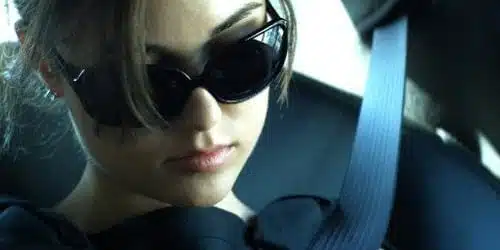
Steven Soderbergh’s The Girlfriend Experience was intended as the second in his series of quickly made, digitally-shot shoestring experimental movies; it still is this, of course, but a pair of circumstances gave it considerably more attention than earlier digital experiment, 2006’s Bubble. First, in filming a few days in the life of a high-priced Manhattan call girl in fall 2008 mostly with non-actors, Soderbergh captured the brink of economic collapse, eerily appropriate for a movie in which New York life is seen as a series of negotiable transactions.
Soderbergh also garnered attention for his choice of adult film star Sasha Grey to play Chelsea, the young, opaque call girl.This is Grey’s first narrative film, and there are obvious parallels between Grey’s porn mini-empire and Chelsea’s business dealings as the latter encounters agents, journalists, and even a sleazy “reviewer” hilariously played by film critic Glenn Kenny.
But Soderbergh, with his characteristically dispassionate and sometimes icy eye, doesn’t enlist Grey for explicit sexuality; her fleeting nakedness is nearly Hollywood-level chaste. Instead, the camera continually zeroes on her face: pretty, unknowable, sometimes out of focus, often shielded by large sunglasses or her fixed expression. Grey may come across as flat and affectless, but whether a product of acting or habit or some combination, her performance is natural, and cunning in its way.
The Girlfriend Experience breaks its slim story into a time-shuffled series of moments, following Chelsea, her uncomfortable personal-trainer boyfriend, and the people they meet — clients, mostly, as the film portrays Manhattan as sort of a living expense report, with a weird bust-driven mixture of desperation and reflexive bravado. Granted, the idea that we’re all hookers of a sort is a simple one, but then, the movie is only 80-minutes long, and Soderbergh’s productivity allows him this kind of focus.
In keeping with his work ethic, Soderbergh insists on engaging commentary tracks with more than one voice, so he corrals Grey for this one, going through sort of an extended Q&A as the movie plays. Grey sounds more expressive and open than her guarded character and her director, as ever, plays the part of the earnest, film-literate nerd. (When Grey mentions her plans to direct an arty adult movie, he mentions his desire to direct a midnight movie, only releasing it for late-night shows — he’s been “thinking about that for awhile,” hinting at what will surely be among the most considered, cerebral midnight movies of all time.) We learn that for a scene where Chelsea needs to let her guard down, Soderbergh filmed her surreptitiously to fill in some gaps.
The movie plays surprisingly well with commentary; the film itself has conversations and monologues from one scene floating over into others, so the director-actress chat feels, at times, like a meta-extension of that technique. During the talk, Soderbergh mentions in passing the disc’s other major feature: an alternate cut of the movie. Despite the fact that it is, per the DVD box, “unrated”, this isn’t a spicier version with the sex scenes Grey’s fans might expect; Soderbergh re-edited his own movie, using different takes and moments, of which this loose, improvised production had many.
Unfortunate, though, that this new cut is presented out of context; you have to hear the commentary to understand that Soderbergh himself prepared it, and even then it’s a surprisingly glancing mention. Even watching the two versions back to back, the differences aren’t always easy to spot; the alternate version is still fragmented and non-linear, though some of it feels slightly less so (whether that’s actually the case would be difficult to sort without side-by-side monitors, or maybe some flow charts). Despite or maybe because of its subtleties, the alternate cut is a fascinating approach to the typical batch of deleted scenes and alternate takes, usually sequestered on their own.
Soderbergh implies, on the commentary, that his altered cut has altered meaning, too, but as loose at the movie can feel, the director may be too controlling for that to be true. Re-scrambling a few scenes or emphasizing different bits of dialogue can’t change the movie’s course. The portrait remains the same: Chelsea remains opaque, and the economic ship is still going down.
